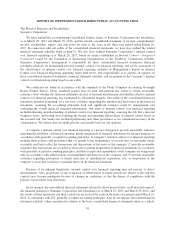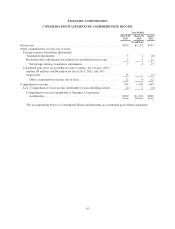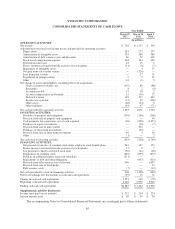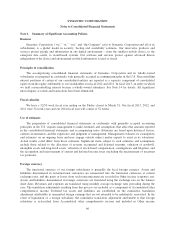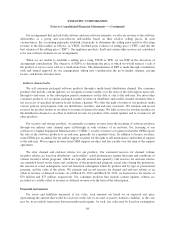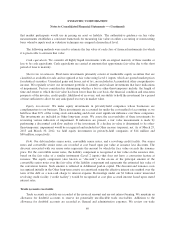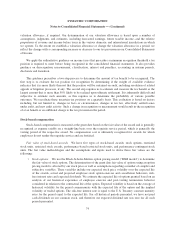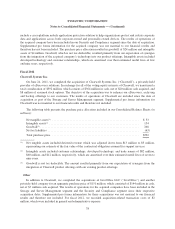Symantec 2013 Annual Report Download - page 167
Download and view the complete annual report
Please find page 167 of the 2013 Symantec annual report below. You can navigate through the pages in the report by either clicking on the pages listed below, or by using the keyword search tool below to find specific information within the annual report.SYMANTEC CORPORATION
Notes to Consolidated Financial Statements — (Continued)
that market participants would use in pricing an asset or liability. The authoritative guidance on fair value
measurements establishes a consistent framework for measuring fair value on either a recurring or nonrecurring
basis whereby inputs used in valuation techniques are assigned a hierarchical level.
The following methods were used to estimate the fair value of each class of financial instruments for which
it is practicable to estimate that value:
Cash equivalents. We consider all highly liquid investments with an original maturity of three months or
less to be cash equivalents. Cash equivalents are carried at amounts that approximate fair value due to the short
period of time to maturity.
Short-term investments. Short-term investments primarily consist of marketable equity securities that are
classified as available-for-sale and recognized at fair value using Level 1 inputs, which are quoted market prices
for identical securities. Unrealized gains and losses, net of tax, are included in Accumulated other comprehensive
income. We regularly review our investment portfolio to identify and evaluate investments that have indications
of impairment. Factors considered in determining whether a loss is other-than-temporary include: the length of
time and extent to which the fair value has been lower than the cost basis, the financial condition and near-term
prospects of the investee, credit quality, likelihood of recovery, and our ability to hold the investment for a period
of time sufficient to allow for any anticipated recovery in market value.
Equity investments. We make equity investments in privately-held companies whose businesses are
complementary to our business. These investments are accounted for under the cost method of accounting, as we
hold less than 20% of the voting stock outstanding and do not exert significant influence over these companies.
The investments are included in Other long-term assets. We assess the recoverability of these investments by
reviewing various indicators of impairment. If indicators are present, a fair value measurement is made by
performing a discounted cash flow analysis of the investment. If a decline in value is determined to be other-
than-temporary, impairment would be recognized and included in Other income (expense), net. As of March 29,
2013 and March 30, 2012, we held equity investments in privately-held companies of $14 million and
$40 million, respectively.
Debt. Our debt includes senior notes, convertible senior notes, and a revolving credit facility.Our senior
notes and convertible senior notes are recorded at cost based upon par value at issuance less discounts. The
discount associated with our senior notes represents the amount by which the face value exceeds the issuance
price. For the convertible senior notes, the liability component is recognized at fair value on the issuance date,
based on the fair value of a similar instrument (Level 2 inputs) that does not have a conversion feature at
issuance. The equity component (also known as “discount”) is the excess of the principal amount of the
convertible senior notes over the fair value of the liability component and represents the estimated fair value of
the conversion feature. Such amount is reflected in Additional paid-in capital. The discount and issuance costs
(recognized initially in the Other long-term assets) are amortized using the effective interest rate method over the
term of the debt as a non-cash charge to interest expense. Borrowings under our $1 billion senior unsecured
revolving credit facility (“credit facility”) would be recognized at cost plus accrued interest based upon stated
interest rates.
Trade accounts receivable
Trade accounts receivable are recorded at the invoiced amount and are not interest bearing. We maintain an
allowance for doubtful accounts to reserve for potentially uncollectible trade receivables. Additions to the
allowance for doubtful accounts are recorded as General and administrative expenses. We review our trade
69


